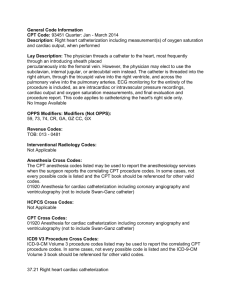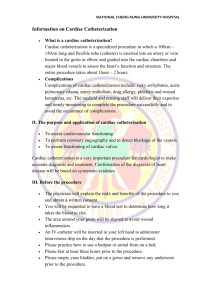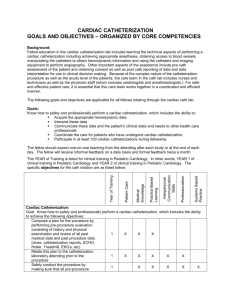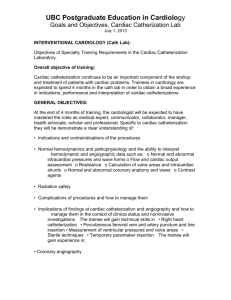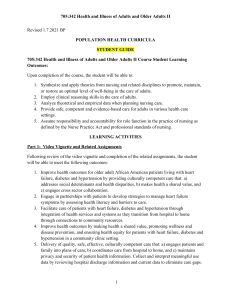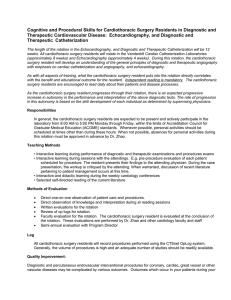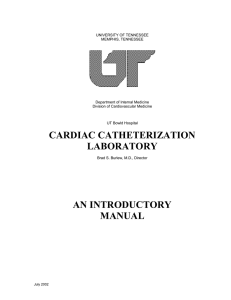CARDIAC CATHETERIZATION
advertisement
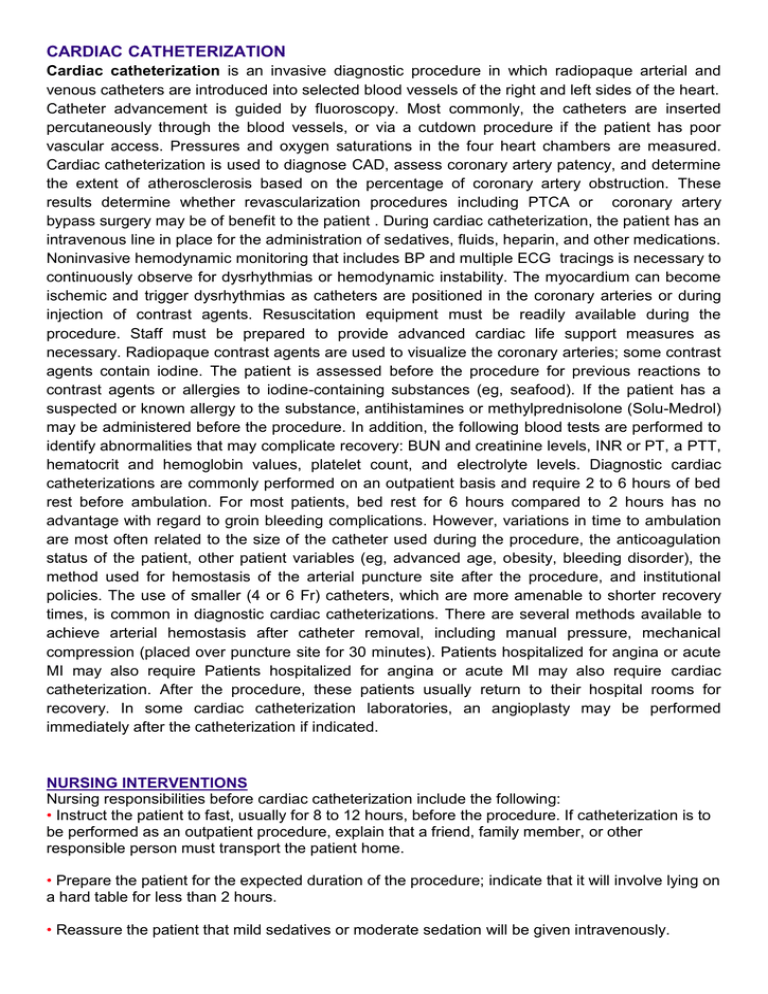
CARDIAC CATHETERIZATION Cardiac catheterization is an invasive diagnostic procedure in which radiopaque arterial and venous catheters are introduced into selected blood vessels of the right and left sides of the heart. Catheter advancement is guided by fluoroscopy. Most commonly, the catheters are inserted percutaneously through the blood vessels, or via a cutdown procedure if the patient has poor vascular access. Pressures and oxygen saturations in the four heart chambers are measured. Cardiac catheterization is used to diagnose CAD, assess coronary artery patency, and determine the extent of atherosclerosis based on the percentage of coronary artery obstruction. These results determine whether revascularization procedures including PTCA or coronary artery bypass surgery may be of benefit to the patient . During cardiac catheterization, the patient has an intravenous line in place for the administration of sedatives, fluids, heparin, and other medications. Noninvasive hemodynamic monitoring that includes BP and multiple ECG tracings is necessary to continuously observe for dysrhythmias or hemodynamic instability. The myocardium can become ischemic and trigger dysrhythmias as catheters are positioned in the coronary arteries or during injection of contrast agents. Resuscitation equipment must be readily available during the procedure. Staff must be prepared to provide advanced cardiac life support measures as necessary. Radiopaque contrast agents are used to visualize the coronary arteries; some contrast agents contain iodine. The patient is assessed before the procedure for previous reactions to contrast agents or allergies to iodine-containing substances (eg, seafood). If the patient has a suspected or known allergy to the substance, antihistamines or methylprednisolone (Solu-Medrol) may be administered before the procedure. In addition, the following blood tests are performed to identify abnormalities that may complicate recovery: BUN and creatinine levels, INR or PT, a PTT, hematocrit and hemoglobin values, platelet count, and electrolyte levels. Diagnostic cardiac catheterizations are commonly performed on an outpatient basis and require 2 to 6 hours of bed rest before ambulation. For most patients, bed rest for 6 hours compared to 2 hours has no advantage with regard to groin bleeding complications. However, variations in time to ambulation are most often related to the size of the catheter used during the procedure, the anticoagulation status of the patient, other patient variables (eg, advanced age, obesity, bleeding disorder), the method used for hemostasis of the arterial puncture site after the procedure, and institutional policies. The use of smaller (4 or 6 Fr) catheters, which are more amenable to shorter recovery times, is common in diagnostic cardiac catheterizations. There are several methods available to achieve arterial hemostasis after catheter removal, including manual pressure, mechanical compression (placed over puncture site for 30 minutes). Patients hospitalized for angina or acute MI may also require Patients hospitalized for angina or acute MI may also require cardiac catheterization. After the procedure, these patients usually return to their hospital rooms for recovery. In some cardiac catheterization laboratories, an angioplasty may be performed immediately after the catheterization if indicated. NURSING INTERVENTIONS Nursing responsibilities before cardiac catheterization include the following: • Instruct the patient to fast, usually for 8 to 12 hours, before the procedure. If catheterization is to be performed as an outpatient procedure, explain that a friend, family member, or other responsible person must transport the patient home. • Prepare the patient for the expected duration of the procedure; indicate that it will involve lying on a hard table for less than 2 hours. • Reassure the patient that mild sedatives or moderate sedation will be given intravenously. • Prepare the patient to experience certain sensations during the catheterization. Knowing what to expect can help the patient cope with the experience. Explain that an occasional pounding sensation (palpitation) may be felt in the chest because of extrasystoles that almost always occur, particularly when the catheter tip touches the myocardium. The patient may be asked to cough and to breathe deeply, especially after the injection of contrast agent. Coughing may help to disrupt a dysrhythmia and to clear the contrast agent from the arteries. Breathing deeply and holding the breath helps to lower the diaphragm for better visualization of heart structures. The injection of a contrast agent into either side of the heart may produce a flushed feeling throughout the body and a sensation similar to the need to void, which subsides in 1 minute or less. • Encourage the patient to express fears and anxieties. Provide teaching and reassurance to reduce apprehension. Nursing responsibilities after cardiac catheterization may include the following: 1. Observe the catheter access site for bleeding or hematoma formation, and assess the peripheral pulses in the affected extremity (dorsalis pedis and posterior tibial pulses in the lower extremity, radial pulse in the upper extremity) every 15 minutes for 1 hour, and then every 1 to 2 hours until the pulses are stable. 2. Evaluate temperature and color of the affected extremity and any patient complaints of pain, numbness, or tingling sensations to determine signs of arterial insufficiency. Report changes promptly. 3. Monitor for dysrhythmias by observing the cardiac monitor or by assessing the apical and peripheral pulses for changes in rate and rhythm. A vasovagal reaction, consisting of bradycardia, hypotension, and nausea, can be precipitated by a distended bladder or by discomfort during removal of the arterial catheter, especially if a femoral site has been used. Prompt intervention is critical; this includes raising the feet and legs above the head, administering intravenous fluids, and administering intravenous atropine. 4. Inform the patient that if the procedure is performed percutaneously through the femoral artery , the patient will remain on bed rest for 2 to 6 hours with the affected leg straight and the head elevated to 30 degrees . For comfort, the patient may be turned from side to side with the affected extremity straight. If the cardiologist uses deployed devices, check local nursing care standards, but anticipate that the patient will have less restrictions on elevation of the head of the bed and will be allowed to ambulate in 2 hours or less . Analgesic medication is administered as prescribed for discomfort. 5. Instruct the patient to report chest pain and bleeding or sudden discomfort from the catheter insertion sites immediately. 6. Encourage fluids to increase urinary output and flush out the dye. 7. Ensure safety by instructing the patient to ask for help when getting out of bed the first time after the procedure, because orthostatic hypotension may occur and the patient may feel dizzy and lightheaded. Patient education after catheterization After discharge from the hospital for cardiac catheterization, guidelines for self-care include the following: • For the next 24 hours, do not bend at the waist (to lift anything), strain, or lift heavy objects. • Avoid tub baths, but shower as desired. • Talk with your physician about when you may return to work, drive, or resume strenuous activities. • Call your physician if any of the following occur: bleeding, swelling, new bruising or pain from your procedure puncture site, temperature of 101.5°F (38.6°C) or more. • If test results show that you have coronary artery disease, talk with your physician about options for treatment, including cardiac rehabilitation programs in your community. • Talk with your physician and nurse about lifestyle changes to reduce your risk for further or future heart problems, such as quitting smoking, lowering your cholesterol level, initiating dietary changes, beginning an exercise program, or losing weight.
